Shipping Books NOW! Bone Tipped & Banded Horns Regional Characteristics of Professionally Made Powder Horns
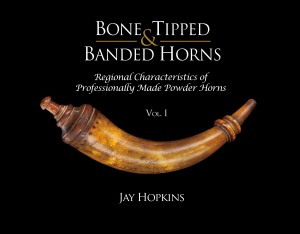 Bone Tipped & Banded Horns
Bone Tipped & Banded Horns
Regional Characteristics of Professionally Made Powder Horns
By Jay Hopkins
Published by The Honourable Company of Horners
For any student of powder horns and or the Kentucky rifle, this is a “must have book” for your personal library.
This first volume of a planned two volume set is the culmination of a 50-year study concentrating on regional characteristics of professionally made powder horns. It has been significantly augmented by collaboration and cooperation with other collectors, students and museums. The focus is on powder horns of the south including Virginia, North Carolina, West Virginia, Tennessee, Kentucky, Georgia, but also includes examples from South Carolina, Alabama, Mississippi, Louisiana, Texas, Missouri, Illinois, Indiana, Ohio, Pennsylvania, New York and New England.
Volume 1 is hardbound with approximately 400 pages, over 150 powder horns illustrated and over 700 full color images. Each horn will be illustrated, measured in multiple parameters and the various materials and woods are identified. Then, pertinent history and biographical information will be included, as well as an analysis of the horn and its likely origin. This study will provide an excellent framework for future study and clarification.
$100.00, plus $10.00 postage.
Payment by cash, check or money order, made to “HCH”:
510 Coffin Alley, PO Box 382
Portland, PA 18351
The HCH Spring Pole Lathe Project Update – November 2015
Guildmaster Dick Toone is the designer and maker (and demonstrator!) of the Guild’s spring pole lathe. The lathe is adapted with purpose built attachments for making powder horn parts. Dick is also the artisan behind The Living History Shop (www.livinghistoryshop.com) where this posting first appeared. It is reproduced here to serve as an update to the project.
In 2011 I undertook the Honourable Company of Horners’ By-Law project that provides the Guild have an 18th Century traveling horn shop for educational demonstration at various 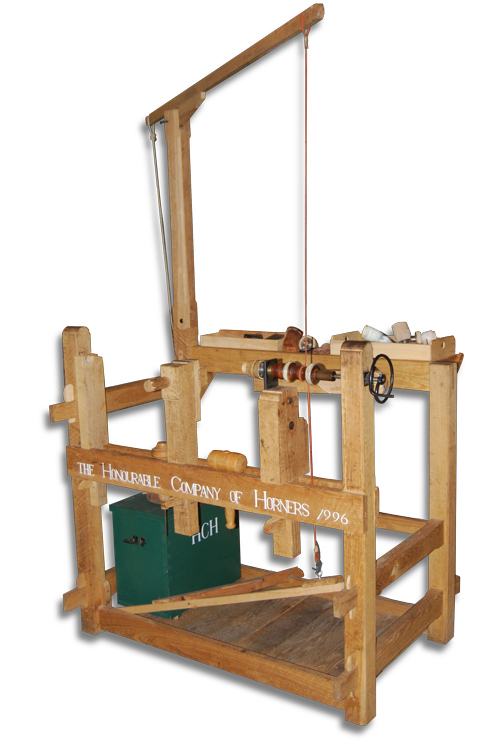 guild related or historical presentations. The lathe is specific to the production of professionally made powder horns using lathe construction detail of an original example capable of turning in open air without fixed centers. A very rare example of this sort of lathe exists in the collections of Old Salem, Winston-Salem, North Carolina.
guild related or historical presentations. The lathe is specific to the production of professionally made powder horns using lathe construction detail of an original example capable of turning in open air without fixed centers. A very rare example of this sort of lathe exists in the collections of Old Salem, Winston-Salem, North Carolina.
Old Salem gave me permission to photograph and measure the original and a full size reproduction made by resident gunsmith Blake Stevenson operating in “The Brothers House” original structure. Old Salem is similar to Colonial Williamsburg other than it is in all original buildings, has working gunsmiths and bread baked in a 250 year old oven. Old Salem should be on every historical enthusiast’s bucket list. (www.oldsalem.org)
Spring Pole lathes were state of the art for about 500 years gradually replaced by large wheel belt driving small wheel lathes using an off-set crank on the large wheel operated by direct coupling to foot driven rocker treadle toward the end of the 1700′s. These later lathes are called treadle lathes (direct continuous drive) even though a treadle board operated spring pole lathes for centuries.
A major part of the lathe challenge was to establish means to hold and turn things with only known to the period devices. This required jigs, fixtures and even tools unique to the operation of a slow turning lathe that only operates one and one-half turn towards the operator per stroke of the foot.
Modern lathes have easily adjustable inner and outer chucks not available in spring pole times. Professionally made powder horns from a Horn Shop would have been constructed of turned components that could be closely fitted round to round for sealing out moisture. “Keep your powder dry!,” as the saying goes.
Professional Horn Shops made various tight containers, combs, buttons, shoe horns, rims for optical lenses(glasses), drinking tumblers and window pane. Yes, flat clear pane for horn books used in schools as well as lanthorns, later called lanterns with glass or mica lenses. When heated cattle horn becomes plastic an adjective meaning malleable. Modern plastic is used as a noun for polymerized, chemical stew that replaced thousands of laborers in the horn industry early last century.
The epicenter of American horn manufacturing was in Philadelphia in the 18th Century boasting twelve shops at the time between the French and Indian war and the American Revolution. Horn smiths looking to strike out on their own relocated to the Southern and Western frontiers producing styles of horn independent of Philadelphia styling allowing researchers today to regionalize examples to a county and sometimes a town by their unique design. The hornsmiths migrated to wherever the frontier moved and the need existed.
Common to almost all professionally made powder horns is a stylized round wooden plug sealed tightly to the heated rounded horn at the big end opening. The tip of the horn is cut off and threaded of a size more suitable for refilling the powder horn. A two to three inch horn tip with a smaller diameter hole is tightly threaded into the main horn. Optimum word tightly to seal. Around the threaded portion of the horn body a horn collar is turned and fitted to provide structural strength to the area around the threaded portion. All of these items need a lathe to make them expertly and each item requires fixtures designed to work within the scope of 18th Century machining. This is experimental archaeology and none of the horns I’ve made are for sale. 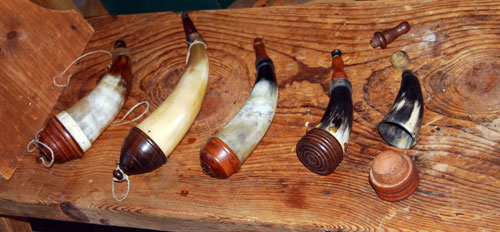
Check out www.hornguild.com for more education about working in cattle horn and this link to see a number of “posts” about the Honourable Company of Horners’ spring pole lathe project.
I will be demonstrating with the Spring Pole Lathe at Horn Guild annual convention in March of 2016, Dixon’s Gun Fair in Kempton, PA and the CLA show in August at Lexington, KY in 2016. I will be demonstrating the lathe local to me at the Jersey History Fair at Monmouth Battle Park Freehold, NJ in May 2016.
Regards,
Dick Toone
June 2014 – The Second Advanced Horn Class at the Boulton Historic Site was a Success.
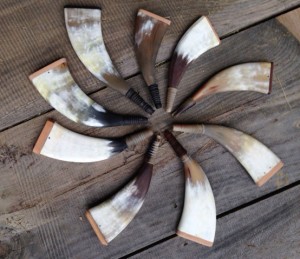 The second Advanced Horn class held at the Jacobsburg Historical Society Craft Center took place on June 7th and 8th in Nazareth, PA. This followed the first class of last year where John DeWald and Frank Willis taught a capacity group of 10 students the art of scrimshaw and horn decoration.
The second Advanced Horn class held at the Jacobsburg Historical Society Craft Center took place on June 7th and 8th in Nazareth, PA. This followed the first class of last year where John DeWald and Frank Willis taught a capacity group of 10 students the art of scrimshaw and horn decoration.
This year John and Frank offered a program to teach students how to make a flat horn with a screw-tip. Hoping to match last year’s full enrollment, they were not prepared for the response they received. 16 students signed up for the class! It was not possible to accommodate that many students for the weekend program. The 2 HCH instructors put their heads together and were able to find a second weekend and split the class in half. The first class, held in June taught 8 horners how to flatten a horn and fashion a screw tip.
The second class is scheduled for the 6th and 7th of September to instruct the remaining 8 students to do the same.
John and Frank worked as a team. John handled the lathe and the turning of the screw tips and Frank oversaw the shaping of the horn, installation of the base plug and the final finish. All the students made great horns. The remaining question is – what do these 2 Horn Guild instructors have planned for next year, perhaps a horn cup with a chimed in bottom?
If you are interested in attending one of these classes taught by HCH members, contact Frank at: 908-246-8935908-246-8935 or ftwillis@ptd.net.
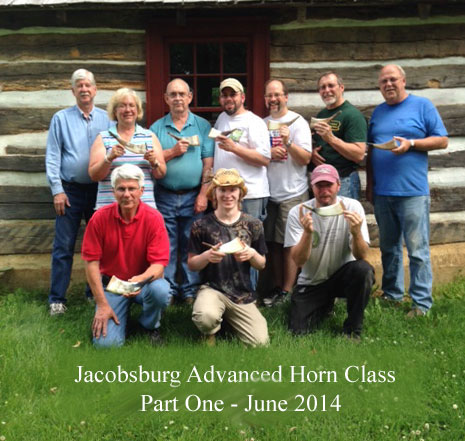
The students standing left to right: Frank Willis – Instructor, Meg Weinhofer, Brian Morris, John DeWald – Instructor, Jim Steele, Roy Finocchio, Gary Steele. Kneeling left to right: Rod Shaker, Jakob Griffing Bianco, Andrew Albanese
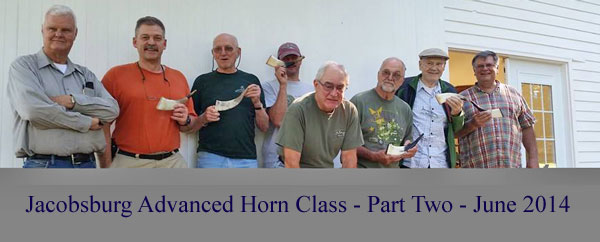
The students Left to right: Hoyt Masterton, Jason Moyer, Rich Hujsa, Andrew Albanese, Todd Searle, John Kochey, Richard Seidel and Ed Weinhofer.
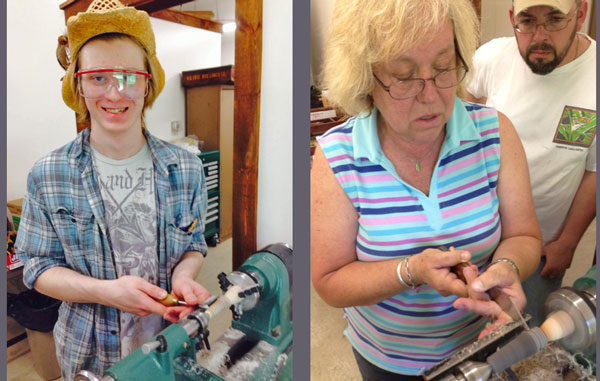
March 2014- The 6th Annual Basic Powder Horn Class at Boulton Historic Site was a Success.
The 6th Annual Basic Powder Horn Class at Boulton Historic Site (Nazareth, PA) was a great success.
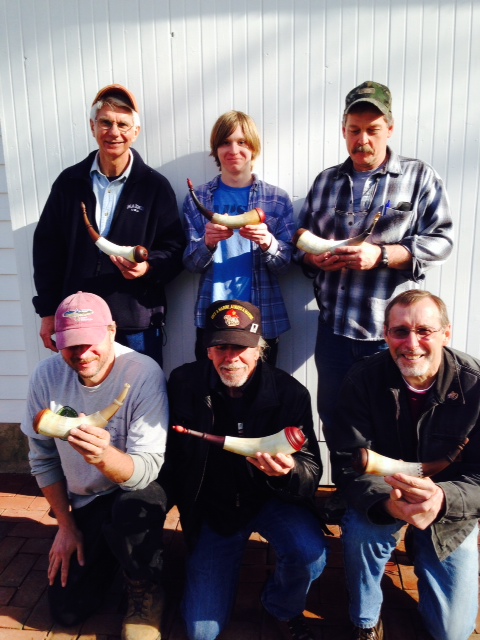
2014 Basic Horn Class at Boulton.
For the 6th year members of The Honourable Company of Horners were active in teaching the basic horn making course . This class is held at the Craft Center located on the grounds of the Bolton Gun Works, where the Henry family made firearms for over a hundred years. The site is managed by the Jacobsburg Historical Society (www.jacobsburghisory.com).
Six students attended and each made a beautiful, early period stepped down horn. This task was completed in four Saturday afternoons in March 2014. One student was a 15 year old that already won a ribbon at Dixon’s last year in the junior category. He was invited to take the course at no charge. Every year Frank Willis, the instructor (and HCH Journeyman Horner), sponsors a youngster who gets to attend the class at no charge.
Many of the students that take the class become Horn Guild members and they are all encouraged to enter their work at Dixon’s Gunmakers Fair in Kepton, Pennsylvania.
A special HCH thanks to Guild members, Hoyt Masterdon, Gary Steele, and John Kochey, who assisted Frank Willis in teaching the class. Also, a big thank you to Roland Cadle and Village Restorations who donating the horns that were used in the class.
All the fees collected are donated to the Jacobsburg Historical Society. The next class is scheduled for January 2015. For more information or to reserve a spot contact Frank Willis at (908-246-8935908-246-8935) or ftwillis@ptd.net
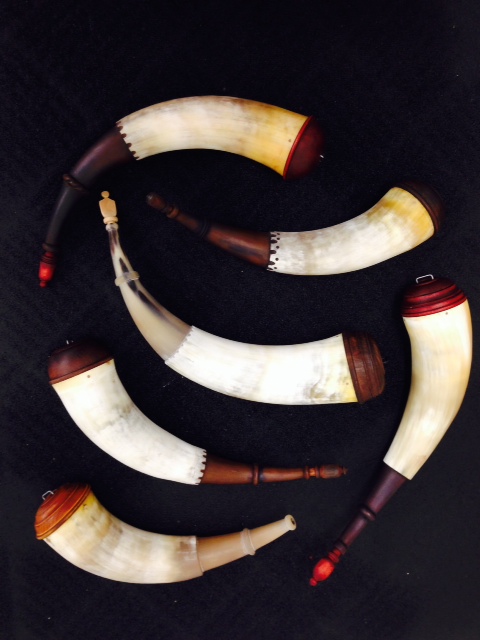
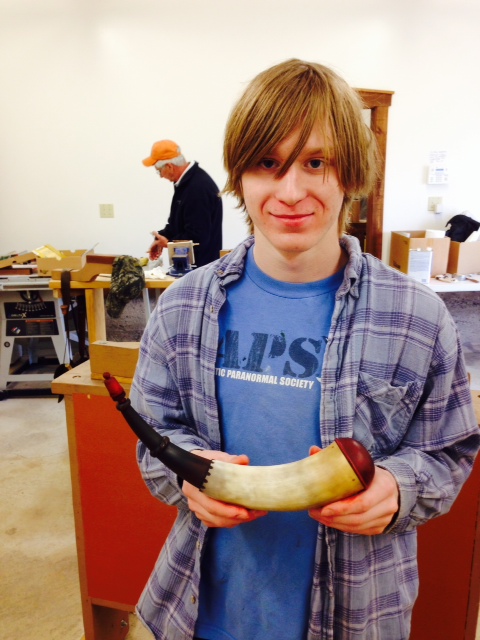
Successful Horn Skills Class Held – Village Restorations in Hollidaysburg, PA on April 11-12, 2014.
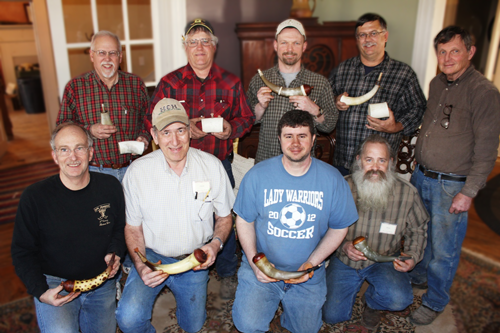
Front row left to right: Art DeCamp instructor, Glenn Hurley, Clay Weaver, Bryan Nye
Back row left to right: Rex Reddick, Sam Thompson, Jason Randolph, Craig Jarrett, Roland Cadle organizer and instructor.
April 11-12, 2014 – Horn Class by Roland Cadle and Art DeCamp – Hollidaysburg, PA
Build a Powder Horn and then color and decorate it with period dyes and stains!
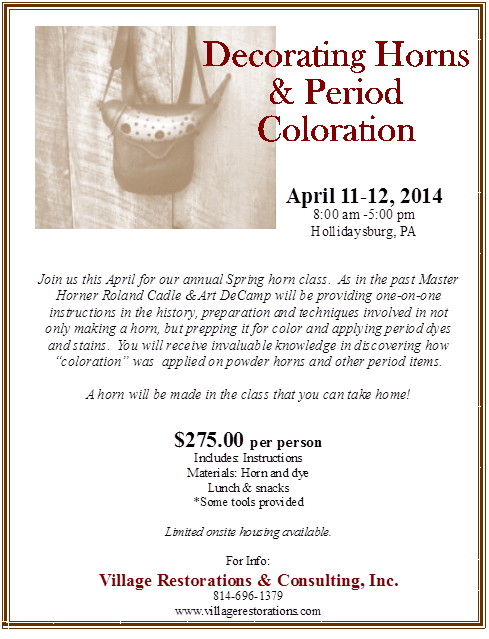
Can You Indentify the Maker of this Horn?
If you can help, please send an email to: curator(put @ here)hornguild.org. Please put “Mystery Horn” in the Subject Line. Thanks, Rick Sheets
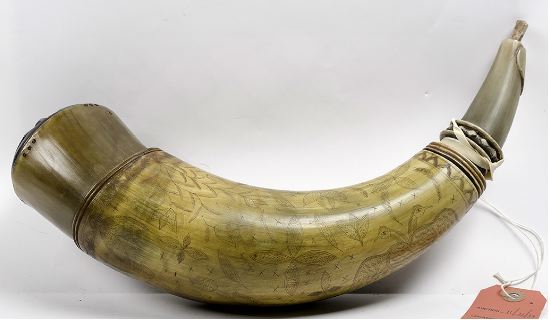
Success! – Horn Skills Class at 24th Annual Conner Prairie Arms Making Workshop
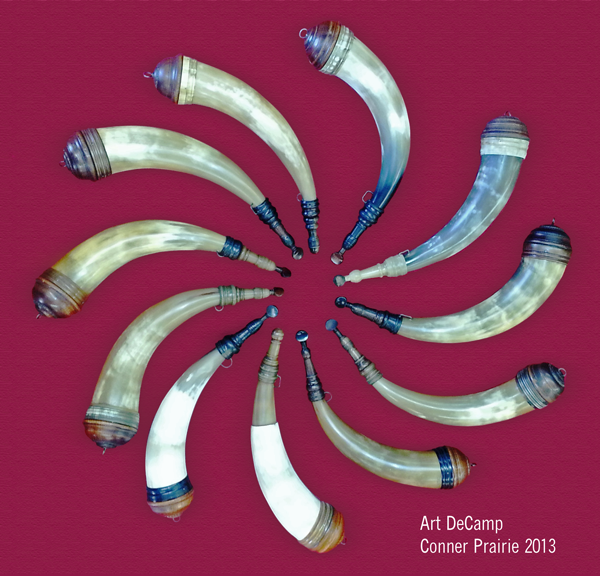
Ten participant horns, plus the one made as a “demonstrator” during the class by instructor Art DeCamp.
The class began with a lecture on screw-tip powder horns in general and the specific historic significance of the Early Philadelphia style. Several original examples of this style were on hand for reference, along with additional contemporary examples. Following the lecture, question and answer period and distribution of the course syllabus, work began in earnest.
Instructor Art DeCamp and his assistant Jim Pease helped all the participants in the class learn how to heat and shape the horn body, turn its ends true in the lathe, cut and fit a horn band, drill, bore and fit the applied collar, turn and thread the internal screw tip, and develop their lathe turning skills on both horn and wood to the point that each was able to produce a very nice rendition of the French & Indian War period style horn that was made in Philadelphia, PA in the late 1750′s through the early 1770′s. With four individual turned horn pieces, and one wood piece this internal screw-tip style horn is one of the most complex types that can be replicated.
The participants came from near and far and included:
- Daniel Boling, Maryville, TN
- Jeff Gier, West Liberty, OH
- David Gundrum, Fortville, IN
- Walter Mabry, Jackson, MS
- Rex Reddick, Denison, TX
- Chris DeCamillis, Traverse City, MI
- Joe Rushton, Tipton, IN
- Brian Shrader, Marion, IN
- Glenn Sutt, Olympia, WA
- Kevin Walden, Russiaville, IN
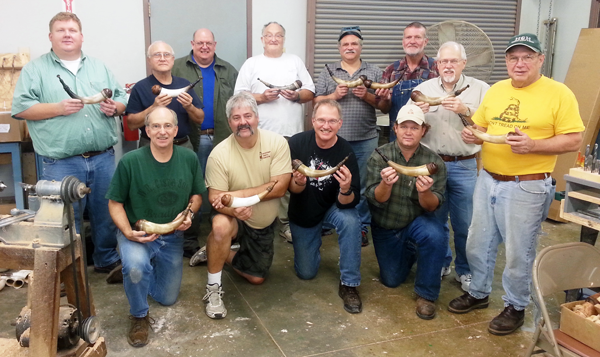
Front row kneeling (L to R): Art DeCamp, instructor, Joe Rushton, Daniel Boling, Jeff Gier, Back row standing (L to R) Brian Shrader, Walter Mabry, Jim Pease, instructor, Dave Gundrum, Chris DeCamillis, Kevin Walden, Rex Reddick, Glenn Sutt (standing on right).
To see more of Art DeCamp’s Master level work, go to his website at: www.artspowderhorns.com.
Nov. 1-2, 2013 – Horn Class by Roland Cadle and Art DeCamp – Hollidaysburg, PA
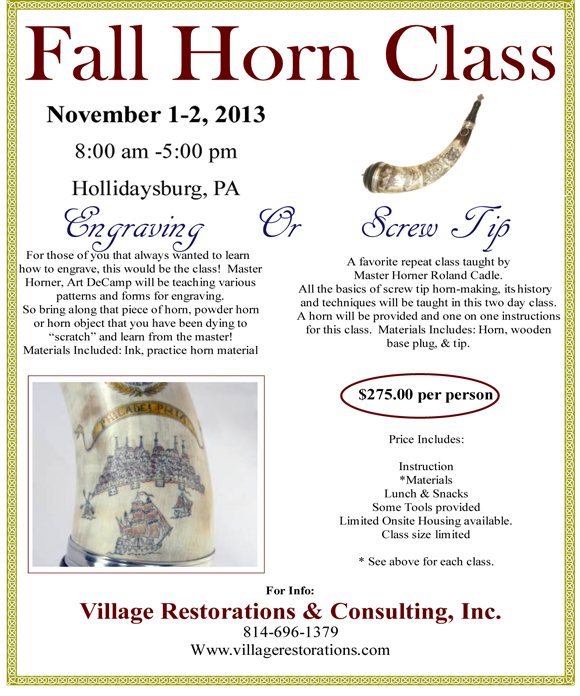 The class is being held at Village Restorations, Inc. in Hollidaysburg, PA. Click Here for their website.
The class is being held at Village Restorations, Inc. in Hollidaysburg, PA. Click Here for their website.






Recent Comments